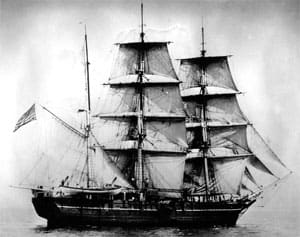Charles W. Morgan is the last remaining American whaling ship of a fleet that once numbered over 2,000 vessels. It was built in New Bedford, Mass., in 1841. Morgan has had a permanent home at the Mystic Seaport Museum since 1941. In that time, the vessel has undergone three major restorations, the last one completed in 2013. It’s the oldest wooden sailing ship in the U.S. other than the USS Constitution.
Named after businessman Charles Wain Morgan, who owned whaling ships as early as 1818, Morgan was built by brothers Jethro and Zachariah Hillman at their shipyard in New Bedford. It was fastened with copper rather than with iron, and built of oak, hemlock and yellow pine. Morgan was originally a full-rigged ship but was modified after the Civil War to a double-topsail barque. The vessel measures 106 feet, 11 inches LOA with a beam of 27 feet, 9 inches, and carries 7,134 square feet of sail.
Morgan first sailed under the command of Capt. Thomas Norton, who on the vessel’s first passage rounded Cape Horn and worked in the Pacific as far north as Alaska. The vessel’s first voyage took three years and three months before it returned to New Bedford in 1845 with a load of 1,600 barrels of sperm oil, 800 barrels of right whale oil and 5 tons of whale bone.
During her long 80-year career, Morgan was always a lucky ship and profitable for her owners, sailing hundreds of thousands of miles in the pursuit of whales, and always with a crew of more than two dozen men from all over the world. The ship made 37 voyages ranging in length from nine months to five years, altogether bringing home 54,483 barrels of sperm whale oil and more than 152,000 pounds of whale bone, the equivalent of about 2,000 whales. Each barrel held about 35 gallons with approximately 26 to 40 barrels per whale, depending on the size. The kill ratio was about 25 whales annually with Morgan earning about $13,500 a year, or about $5 million today.
Let’s join Capt. Norton on the first passage. On June 29, Capt. Norton does a lower limb sun shot. Height of eye is 20 feet and there is no sextant or time error. According to Michael P. Dyer, curator of maritime history at the New Bedford Whaling Museum, it was not uncommon for whaling ships to be outfitted with chronometers. I had always assumed that most of the celestial navigation was done without timepieces, using LAN to find latitude. I need to make a trip to the museum and examine some logbooks; I need convincing to accept that the thrifty Quaker owners provided their ships with expensive timepieces. That aside, the DR for Morgan at the time of the sight is 56° 20’ N by 145° 10’ W. The local time at the time of the observation is 16:35:25. Hs is 29° 56’.
A. What is the time in GMT?
B. What is the Ho?
C. Plot the sun line. What is the EP?
Answers
A. GMT is 02:25:35, June 30
B. Ho is 30° 06.0’
C. EP is 56° 20’ N, 145° 27’ W

